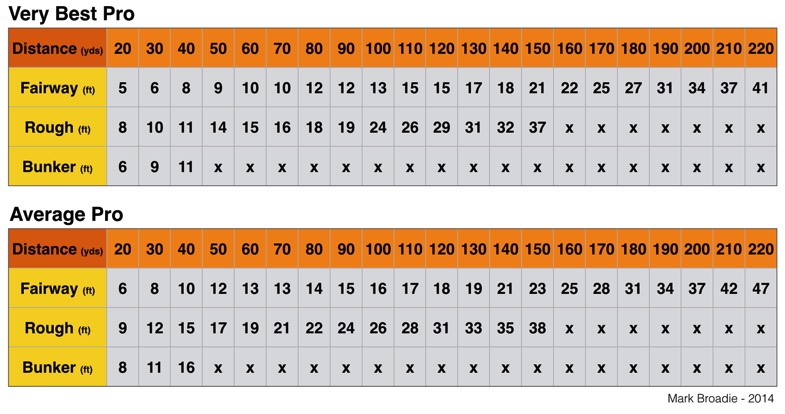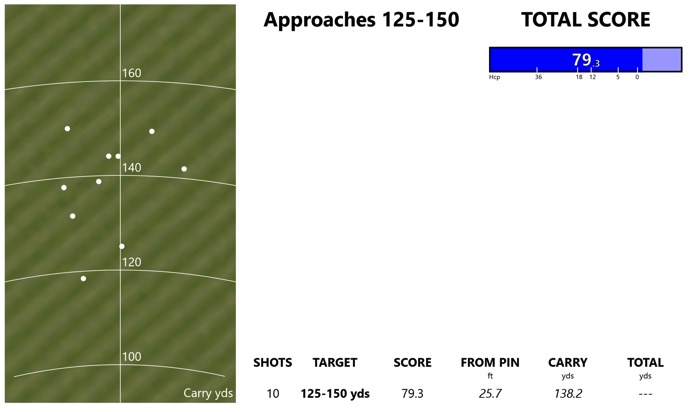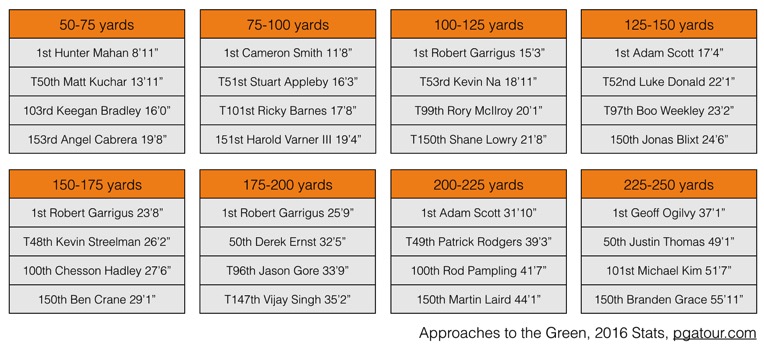Elite Player Benchmarking with Trackman
Elite Player Benchmarking & Practice with Trackman
One of the benefits of training with Trackman is the feedback both the player and coach receive with regards to the ball flight and club data. Being able to demonstrate progress and the effect of different moves on the numbers is invaluable for the coach. Being able to create a feel for the swing when a certain set of numbers is created is invaluable for the player as having quality feedback invariably speeds up the learning process. Another benefit is the ability to create meaningful practice scenarios via the Trackman Test Centre and to use these to benchmark players’ ability. In this article I will share two of the exercises I use with elite golfers but first let’s look at some of the aspects that must be present in order to make the most of your practice sessions.
How to make your practice count?
It is important to practice with a purpose and for there to be a consequence to the shots you hit while training. There are countless examples of golfers who spend hour after hour on the driving range hitting shot after shot and who in the long run achieve very little other than perhaps the ability to hit nice looking shots on the driving range. This is largely due to the fact they are hitting golf shots out of context as there is no reward or penalty for good and bad shots, there is always the opportunity to hit one more shot. Driving ranges also tend to be fairly wide making it difficult to evaluate the true worth of each shot. Perhaps the only shot that has real consequence when people practice on the range is the one with the last ball in the range basket. If you hit that shot badly the session ends on a disappointing note and if you hit it well you go home thinking all is well and your game is in shape. In fact, I often see golfers get around this problem by actually stopping their practice sessions a few balls shy of the last ball in the basket. A good shot is hit, there are three balls left in the basket and the golfer doesn’t bother to hit the last three as he wants to finish with a good one. Try not to be guilty of this as sadly, this is not how it works when you are out on the golf course, there are no second serves and every shot counts. You want to try and replicate the pressure you feel on the first tee on all the shots you hit during your practice. It is important to try and make practice simulate the real game as closely as possible, perhaps even at times making it harder than the game itself. It is also important for you to be able to quantify your practice in terms of your performance and not simply in terms of the time spent hitting balls. Practice with all these things in mind and you will maximise your chances of improving.
- MAKE IT MEASURABLE (OBJECTIVE NOT SUBJECTIVE) - MAKE IT REAL (CONSEQUENCE AND PRESSURE) - MAKE IT HARD
Test Centre assessments for elite players
As I said earlier, there are many benefits to Trackman, not simply to do with the quality of the data but to do with the actual method of training and the ability to monitor results. No doubt most people who regularly work with a Trackman unit have at some stage carried out a combine test. The Combine is a standardised test asking golfers to hit 60 shots at 10 different targets and gives all shots a score out of 100. Because of the sheer number of people who have taken the test it allows comparisons to be made between golfers of different abilities. If you’ve ever taken this test you will know the pressure that is created by knowing that your score will be posted on a worldwide leaderboard for your friends and
everyone to see. The Test feature on the software also allows specific tests to be designed.
The following are two tests/games I carry out with elite and aspiring players 1. Beat the Pro
This first test is based on the information gathered by shotlink on the PGA Tour and the work done by Mark Broadie that he discusses in detail in his book “Every Shot Counts”. In the book, he lists the average proximity to the hole from a number of distances and a number of lies for both the very best pro and the average pro on the PGA Tour. I have collated this data in the table below.

A good time to carry out this test is when you have established a particular distance that you wish to improve. This could for example be following a Combine Test where you have determined that your weakest distances are 90 yards and 180 yards or following a round of golf where you hit some errant shots that you didn’t like from specific distances.
The object of the game is to hit 9 shots from your selected distance and establish whether you can beat the average PGA Tour Pro or even the very best PGA Tour Pro. You receive 1 point for beating the average pro and 2 points if you beat the best pro. This means that the game is scored out of 18 points in total. You must change the target every three shots in order for the shots not to become too repetitive and simulate golf as closely as possible. As an example, you have decided that 140 yards is a weakness. Create a Trackman test with 9 shots at 140 yards. Select a target and hit the first three shots. If your ball finishes between 21 and 19 feet from the pin you receive one point and if it finishes 18 feet or closer to the pin you receive 2 points. After the first three shots change the target and repeat. Tally up the score at the end out of 18 to establish your result for that session.
You are only allowed to carry out the test at each distance once per practice session. Remember there are no second serves in golf and you want to carry out the test in a pressured environment. If you could simply take it again after an unsatisfactory result that would be too easy. There is nothing better than simulating pressure if you want to perform well under pressure when you’re competing. I would urge you to keep a record of your results and to write them down in a little notebook, there is nothing quite like putting pen to paper. Notice you can also carry out this test from the rough and to benchmark yourself on bunker shots up to 40 yards.
2. Race to Number One
This second test is based on the info gathered by Shot link on the PGA Tour and the stats that are kept on pgatour.com in the accuracy from fairway section. These stats list the average proximity to the hole for all PGA Tour players from between set distances. In 2016 for example, from 50-75 yards Hunter Mahan lead the tour by finishing just 8’11” from the hole when playing shots from the fairway from that range. This is a test you can also carry out with aspiring elite players in order to establish which areas might need improvement and the gap that must be filled between their performance and that of a PGA Tour player.
The yardages the PGA Tour keep statistics for are: 50-75 yards / 75-100 yards / 100-125 yards / 125-150 yards / 150-175 yards / 175-200 yards / 200-225 yards / 225-250 yards / 250-275 yards
The Tour also keeps statistics for wider windows such as 50-125 yards but I don’t tend to use these as the data could be biased if you were doing a Random Test depending on whether Trackman gave you more shorter or more longer shots.
Carrying out this test involves hitting 10 shots and establishing your average distance from the pin from the range you have selected. Let’s set it up as though you were working on 125 to 150 yards. Create a Random Test on Trackman setting the lower distance as 125 and the upper distance as 150 yards, select 10 shots. Select your target and hit two shots at the required distance towards that target. Every couple of shots you must aim the Trackman at a different target. Carry on until you have hit all 10 shots. Once you have finished check the Report and see what your average distance from the pin is and compare it to the players on the PGA Tour.
The following is a test report after conducting a 125-150 yards test. This player’s result is circled in red and indicates, using the “Approaches to the Green” table below, he is 1’1” outside 150th place on the PGA Tour from that range meaning there is some work to be done in this area.


If you visit the PGA Tour website you will notice that average distances are also worked out for shots hit from the rough. This means that just like the first test, you could also carry out this second test from the rough. If you want to further increase the difficulty of this test you can play shots with the ball resting on uneven lies (above, below, uphill, downhill), just make sure you don’t pay too much attention to the club data when you do this.
It is important to note that Trackman’s distance from the pin measurement is based on where the ball landed using carry flat. It’s very much like throwing darts, Trackman is asking can you land it as close as possible to your target? The statistics from the Tour, however, are taken from shots hit on the golf course and this means that the players have to take into account how the ball is going to respond when it lands. It also means that at times the golfers may not be aiming straight at the flag. Nonetheless, these two exercises provide you with some very real targets to beat and measure yourself against.
Remember, it is important for you to simulate real golf as closely as possible when practicing. You need to feel a sense of pressure otherwise you will not be able to replicate your new skills when you are out on the golf course. Every shot needs to have a purpose and every shot must count. When possible, your practice should be harder than the real thing. These two tests will allow you to gauge your current ability and help you and your coach structure your practice.
Please let me know how you get on, I look forward to hearing your results.
One of the benefits of training with Trackman is the feedback both the player and coach receive with regards to the ball flight and club data. Being able to demonstrate progress and the effect of different moves on the numbers is invaluable for the coach. Being able to create a feel for the swing when a certain set of numbers is created is invaluable for the player as having quality feedback invariably speeds up the learning process. Another benefit is the ability to create meaningful practice scenarios via the Trackman Test Centre and to use these to benchmark players’ ability. In this article I will share two of the exercises I use with elite golfers but first let’s look at some of the aspects that must be present in order to make the most of your practice sessions.
How to make your practice count?
It is important to practice with a purpose and for there to be a consequence to the shots you hit while training. There are countless examples of golfers who spend hour after hour on the driving range hitting shot after shot and who in the long run achieve very little other than perhaps the ability to hit nice looking shots on the driving range. This is largely due to the fact they are hitting golf shots out of context as there is no reward or penalty for good and bad shots, there is always the opportunity to hit one more shot. Driving ranges also tend to be fairly wide making it difficult to evaluate the true worth of each shot. Perhaps the only shot that has real consequence when people practice on the range is the one with the last ball in the range basket. If you hit that shot badly the session ends on a disappointing note and if you hit it well you go home thinking all is well and your game is in shape. In fact, I often see golfers get around this problem by actually stopping their practice sessions a few balls shy of the last ball in the basket. A good shot is hit, there are three balls left in the basket and the golfer doesn’t bother to hit the last three as he wants to finish with a good one. Try not to be guilty of this as sadly, this is not how it works when you are out on the golf course, there are no second serves and every shot counts. You want to try and replicate the pressure you feel on the first tee on all the shots you hit during your practice. It is important to try and make practice simulate the real game as closely as possible, perhaps even at times making it harder than the game itself. It is also important for you to be able to quantify your practice in terms of your performance and not simply in terms of the time spent hitting balls. Practice with all these things in mind and you will maximise your chances of improving.
- MAKE IT MEASURABLE (OBJECTIVE NOT SUBJECTIVE) - MAKE IT REAL (CONSEQUENCE AND PRESSURE) - MAKE IT HARD
Test Centre assessments for elite players
As I said earlier, there are many benefits to Trackman, not simply to do with the quality of the data but to do with the actual method of training and the ability to monitor results. No doubt most people who regularly work with a Trackman unit have at some stage carried out a combine test. The Combine is a standardised test asking golfers to hit 60 shots at 10 different targets and gives all shots a score out of 100. Because of the sheer number of people who have taken the test it allows comparisons to be made between golfers of different abilities. If you’ve ever taken this test you will know the pressure that is created by knowing that your score will be posted on a worldwide leaderboard for your friends and
everyone to see. The Test feature on the software also allows specific tests to be designed.
The following are two tests/games I carry out with elite and aspiring players 1. Beat the Pro
This first test is based on the information gathered by shotlink on the PGA Tour and the work done by Mark Broadie that he discusses in detail in his book “Every Shot Counts”. In the book, he lists the average proximity to the hole from a number of distances and a number of lies for both the very best pro and the average pro on the PGA Tour. I have collated this data in the table below.

A good time to carry out this test is when you have established a particular distance that you wish to improve. This could for example be following a Combine Test where you have determined that your weakest distances are 90 yards and 180 yards or following a round of golf where you hit some errant shots that you didn’t like from specific distances.
The object of the game is to hit 9 shots from your selected distance and establish whether you can beat the average PGA Tour Pro or even the very best PGA Tour Pro. You receive 1 point for beating the average pro and 2 points if you beat the best pro. This means that the game is scored out of 18 points in total. You must change the target every three shots in order for the shots not to become too repetitive and simulate golf as closely as possible. As an example, you have decided that 140 yards is a weakness. Create a Trackman test with 9 shots at 140 yards. Select a target and hit the first three shots. If your ball finishes between 21 and 19 feet from the pin you receive one point and if it finishes 18 feet or closer to the pin you receive 2 points. After the first three shots change the target and repeat. Tally up the score at the end out of 18 to establish your result for that session.
You are only allowed to carry out the test at each distance once per practice session. Remember there are no second serves in golf and you want to carry out the test in a pressured environment. If you could simply take it again after an unsatisfactory result that would be too easy. There is nothing better than simulating pressure if you want to perform well under pressure when you’re competing. I would urge you to keep a record of your results and to write them down in a little notebook, there is nothing quite like putting pen to paper. Notice you can also carry out this test from the rough and to benchmark yourself on bunker shots up to 40 yards.
2. Race to Number One
This second test is based on the info gathered by Shot link on the PGA Tour and the stats that are kept on pgatour.com in the accuracy from fairway section. These stats list the average proximity to the hole for all PGA Tour players from between set distances. In 2016 for example, from 50-75 yards Hunter Mahan lead the tour by finishing just 8’11” from the hole when playing shots from the fairway from that range. This is a test you can also carry out with aspiring elite players in order to establish which areas might need improvement and the gap that must be filled between their performance and that of a PGA Tour player.
The yardages the PGA Tour keep statistics for are: 50-75 yards / 75-100 yards / 100-125 yards / 125-150 yards / 150-175 yards / 175-200 yards / 200-225 yards / 225-250 yards / 250-275 yards
The Tour also keeps statistics for wider windows such as 50-125 yards but I don’t tend to use these as the data could be biased if you were doing a Random Test depending on whether Trackman gave you more shorter or more longer shots.
Carrying out this test involves hitting 10 shots and establishing your average distance from the pin from the range you have selected. Let’s set it up as though you were working on 125 to 150 yards. Create a Random Test on Trackman setting the lower distance as 125 and the upper distance as 150 yards, select 10 shots. Select your target and hit two shots at the required distance towards that target. Every couple of shots you must aim the Trackman at a different target. Carry on until you have hit all 10 shots. Once you have finished check the Report and see what your average distance from the pin is and compare it to the players on the PGA Tour.
The following is a test report after conducting a 125-150 yards test. This player’s result is circled in red and indicates, using the “Approaches to the Green” table below, he is 1’1” outside 150th place on the PGA Tour from that range meaning there is some work to be done in this area.


If you visit the PGA Tour website you will notice that average distances are also worked out for shots hit from the rough. This means that just like the first test, you could also carry out this second test from the rough. If you want to further increase the difficulty of this test you can play shots with the ball resting on uneven lies (above, below, uphill, downhill), just make sure you don’t pay too much attention to the club data when you do this.
It is important to note that Trackman’s distance from the pin measurement is based on where the ball landed using carry flat. It’s very much like throwing darts, Trackman is asking can you land it as close as possible to your target? The statistics from the Tour, however, are taken from shots hit on the golf course and this means that the players have to take into account how the ball is going to respond when it lands. It also means that at times the golfers may not be aiming straight at the flag. Nonetheless, these two exercises provide you with some very real targets to beat and measure yourself against.
Remember, it is important for you to simulate real golf as closely as possible when practicing. You need to feel a sense of pressure otherwise you will not be able to replicate your new skills when you are out on the golf course. Every shot needs to have a purpose and every shot must count. When possible, your practice should be harder than the real thing. These two tests will allow you to gauge your current ability and help you and your coach structure your practice.
Please let me know how you get on, I look forward to hearing your results.
